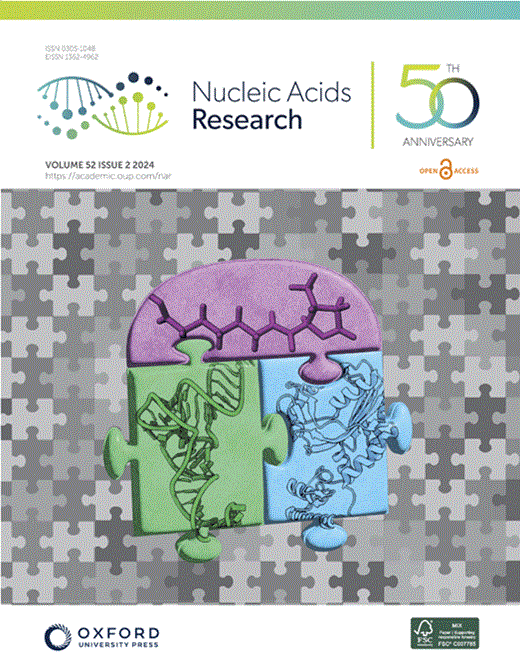单分子可视化设计 PPR 蛋白与序列特异性 RNA 的结合
IF 13.1
2区 生物学
Q1 BIOCHEMISTRY & MOLECULAR BIOLOGY
引用次数: 0
摘要
五肽重复蛋白(PPR)是一个庞大的模块化 RNA 结合蛋白家族,其中的每个模块都可以进行修饰以结合到特定的 ssRNA 核碱基上。因此,人们有兴趣开发 "设计型 "PPR(dPPR),用于一系列生物技术应用,包括诊断或 ssRNA 的体内定位;然而,有关 PPR 如何搜索目标序列并与之结合的机理细节尚不清楚。为了解决这个问题,我们确定了 dPPR 与其目标序列结合的结构,并使用双色和三色单分子荧光共振能量转移来实时检测 ssRNA 与单个 dPPR 结合的机制。我们证明,dPPRs 结合较长 ssRNA 序列的速度较慢(或根本无法结合),部分原因是它们倾向于形成稳定的二级结构,将目标序列从 dPPR 中封存起来。重要的是,dPPR 只与其目标序列结合(即不与非目标 ssRNA 序列结合),不会 "扫描 "较长的 ssRNA 寡核苷酸以寻找目标序列。随机三维扩散所带来的动力学限制或许可以解释为什么 PPR 蛋白在细胞器中含量丰富,而在细胞器外(即在细胞质和细胞核中)却几乎无人知晓这一长期存在的难题。本文章由计算机程序翻译,如有差异,请以英文原文为准。
Single-molecule visualization of sequence-specific RNA binding by a designer PPR protein
Pentatricopeptide repeat proteins (PPR) are a large family of modular RNA-binding proteins, whereby each module can be modified to bind to a specific ssRNA nucleobase. As such, there is interest in developing ‘designer’ PPRs (dPPRs) for a range of biotechnology applications, including diagnostics or in vivo localization of ssRNA species; however, the mechanistic details regarding how PPRs search for and bind to target sequences is unclear. To address this, we determined the structure of a dPPR bound to its target sequence and used two- and three-color single-molecule fluorescence resonance energy transfer to interrogate the mechanism of ssRNA binding to individual dPPRs in real time. We demonstrate that dPPRs are slower to bind longer ssRNA sequences (or could not bind at all) and that this is, in part, due to their propensity to form stable secondary structures that sequester the target sequence from dPPR. Importantly, dPPR binds only to its target sequence (i.e. it does not associate with non-target ssRNA sequences) and does not ‘scan’ longer ssRNA oligonucleotides for the target sequence. The kinetic constraints imposed by random 3D diffusion may explain the long-standing conundrum of why PPR proteins are abundant in organelles, but almost unknown outside them (i.e. in the cytosol and nucleus).
求助全文
通过发布文献求助,成功后即可免费获取论文全文。
去求助
来源期刊

Nucleic Acids Research
生物-生化与分子生物学
CiteScore
27.10
自引率
4.70%
发文量
1057
审稿时长
2 months
期刊介绍:
Nucleic Acids Research (NAR) is a scientific journal that publishes research on various aspects of nucleic acids and proteins involved in nucleic acid metabolism and interactions. It covers areas such as chemistry and synthetic biology, computational biology, gene regulation, chromatin and epigenetics, genome integrity, repair and replication, genomics, molecular biology, nucleic acid enzymes, RNA, and structural biology. The journal also includes a Survey and Summary section for brief reviews. Additionally, each year, the first issue is dedicated to biological databases, and an issue in July focuses on web-based software resources for the biological community. Nucleic Acids Research is indexed by several services including Abstracts on Hygiene and Communicable Diseases, Animal Breeding Abstracts, Agricultural Engineering Abstracts, Agbiotech News and Information, BIOSIS Previews, CAB Abstracts, and EMBASE.
 求助内容:
求助内容: 应助结果提醒方式:
应助结果提醒方式:


